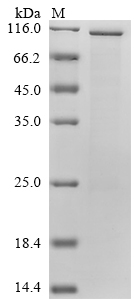Recombinant Human Myc proto-oncogene protein (MYC), Biotinylated, is produced in E. coli and contains the complete sequence of isoform 1, covering residues 1-439. The protein carries both an N-terminal MBP tag and a C-terminal 6xHis-Avi tag, which appears to offer flexibility across different experimental setups. SDS-PAGE analysis confirms purity levels exceeding 85%, suggesting it's well-suited for research applications.
MYC functions as a transcription factor that regulates gene expression linked to cell cycle progression, apoptosis, and cellular transformation. Its involvement in growth and proliferation pathways makes it central to cancer biology research and cell cycle investigations, though the complexity of its regulatory networks is still being unraveled.
Potential Applications
Note: The applications listed below are based on what we know about this protein's biological functions, published research, and experience from experts in the field. However, we haven't fully tested all of these applications ourselves yet. We'd recommend running some preliminary tests first to make sure they work for your specific research goals.
Based on the provided information, the recombinant human MYC protein is expressed in E. coli, a prokaryotic system that is fundamentally unsuitable for producing a functional eukaryotic transcription factor like MYC. MYC requires precise folding, heterodimerization with its partner MAX, and specific post-translational modifications for its DNA-binding and transcriptional activity. E. coli lacks the eukaryotic chaperones and modification machinery necessary for proper MYC folding and function. The presence of large fusion tags (N-terminal MBP and C-terminal 6xHis-Avi) significantly increases the likelihood of improper folding and may sterically hinder the critical bHLH-ZIP domain required for MAX dimerization and DNA binding. While the protein is full-length (1-439aa) with >85% purity, the expression system makes it highly probable to be misfolded and inactive. Since activity is unverified, the protein cannot be assumed to be correctly folded or bioactive without experimental validation.
1. Protein-Protein Interaction Studies Using Streptavidin-Based Pull-Down Assays
The biotinylation enables technical feasibility for pull-down assays via streptavidin binding. However, if MYC is misfolded (as expected in E. coli), it will not interact physiologically with true binding partners like MAX. The bHLH-ZIP domain requires precise conformation for specific dimerization. Identified interactions may be non-physiological artifacts. This application should not be pursued without prior validation of proper folding and MAX dimerization capability.
2. Development and Validation of Anti-MYC Antibodies
This application is appropriate. The recombinant MYC can serve as an immunogen for generating antibodies that recognize linear epitopes, even if misfolded. The full-length sequence ensures broad epitope coverage. However, antibodies may not recognize conformational epitopes of native, properly folded MYC in complex with MAX. Validation against native MYC from mammalian cells is essential.
3. Biochemical Characterization and Protein Stability Studies
This application is well-suited and should be prioritized. Techniques like circular dichroism spectroscopy, analytical ultracentrifugation, and thermal shift assays can directly assess the protein's folding state, oligomerization, and stability. These studies are valuable even if the protein is inactive, as they characterize the recombinant MYC protein itself.
4. Competitive Binding Assays for Small Molecule Screening
This application is highly problematic without activity verification. If MYC is misfolded, it will not bind DNA or interact properly with MAX, making small-molecule screening campaigns meaningless. Compounds identified would likely target non-physiological conformations. This application requires prior validation of MYC-MAX dimerization and DNA-binding activity.
Final Recommendation & Action Plan
Given the high probability of misfolding in E. coli for this complex transcription factor, we recommend first performing comprehensive biophysical and functional validation: 1) Biophysical characterization (circular dichroism for secondary structure, size-exclusion chromatography with multi-angle light scattering for oligomeric state) to assess folding; 2) Functional validation using electrophoretic mobility shift assays (EMSA) to test MYC-MAX heterodimer formation and DNA-binding capability. Antibody development can proceed immediately, but avoid all interaction and screening studies until proper folding and dimerization activity are confirmed. For reliable MYC functional studies, obtain the protein from mammalian expression systems capable of proper folding and post-translational modifications.






